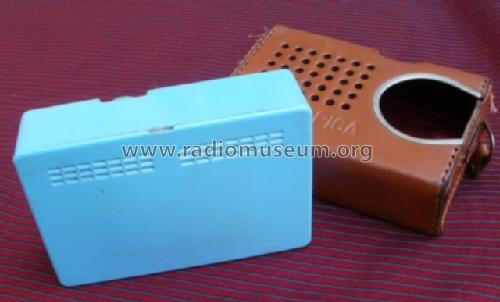Spica Transistor Six ST-600
Sanritsu Electric Co., Japan Transformer Works, Sanritz; Tokyo
- Pays
- Japon
- Fabricant / Marque
- Sanritsu Electric Co., Japan Transformer Works, Sanritz; Tokyo
- Année
- 1958 ?
- Catégorie
- Radio - ou tuner d'après la guerre 1939-45
- Radiomuseum.org ID
- 117927
Cliquez sur la vignette du schéma pour le demander en tant que document gratuit.
- No. de transistors
- 6
- Principe général
- Super hétérodyne (en général); FI/IF 455 kHz; 2 Etage(s) BF
- Circuits accordés
- 5 Circuits MA (AM)
- Gammes d'ondes
- PO uniquement
- Tension / type courant
- Piles sèches / 4 × UM3 = 6 Volt
- Haut-parleur
- HP dynamique à aimant permanent + bobine mobile / Ø 2.75 inch = 7 cm
- Puissance de sortie
- 0.27 W (qualité inconnue)
- Matière
- Plastique moderne (pas de bakélite, ni de catalin)
- De Radiomuseum.org
- Modèle: Spica Transistor Six ST-600 - Sanritsu Electric Co., Japan
- Forme
- Portable, appareil de poche. Taille < 20cm
- Dimensions (LHP)
- 126 x 85 x 34 mm / 5 x 3.3 x 1.3 inch
- Remarques
-
The model Spica ST-600 from Sanritsu Electric Machine Co. was available in different cabinet colors.
There are different dial scale designs (arrows, 5-point star, 3-point star). The model was also made with alternative transistor complements, e.g. 2SA52, 2SA49, 2SA53, 2SB54, and 2× 2SB56.
At least two circuit boards have been used. The easiest way to recognize them is to look at the I.F. transformers which either may be on the same line, or offset. The relationship, if any, between the different circuit boards and the different dials is not known with certainty.
The ST-600 comes with its original gift box, leather carry case, leather earphone case, earphone, instructions and warranty card.
Sanritsu released a vertical version of this radio, model Spica ST-608.
There is also a similar seven transistor variant with a plain gold textured speaker grill named Spica Super 7. Other radios with similar appearance are found under the names Holiday, Impala and Spiket Deluxe.
- Poids net
- 0.3 kg / 0 lb 10.6 oz (0.661 lb)
- Prix de mise sur le marché
- 149.00 DM
- Littérature
- Collector's Guide To TrR1 Bunis trans.94 (1996, page 261)
- Schémathèque (1)
- Funk-Technik (FT) (4/1958, S. 123)
- Auteur
- Modèle crée par Mario Bermejo. Voir les propositions de modification pour les contributeurs supplémentaires.
- D'autres Modèles
-
Vous pourrez trouver sous ce lien 38 modèles d'appareils, 35 avec des images et 6 avec des schémas.
Tous les appareils de Sanritsu Electric Co., Japan Transformer Works, Sanritz; Tokyo
Collections
Le modèle Spica Transistor Six fait partie des collections des membres suivants.
- Mario Bermejo (RA)
- William J Blanchflower (GB)
- Jose Duarte Costa (P)
- Angelo Daniele (I)
- Nigel Durrant (CDN)
- John Hupse † 28.9.20 (NL)
- Lucas Lopardo (RA)
- Dario Marujo (RA)
- Hector Ruben Menendez (RA)
- Jose Mesquita (P)
- Rodolfo Gaston Wenceslao Nasasta (RA)
- Enrique Palacio (RA)
- José Manuel Silvestre (P)
- Francisc VISKY (RO)
- Eckhard Wegner (D)
- Fabio Zannier (I)
































